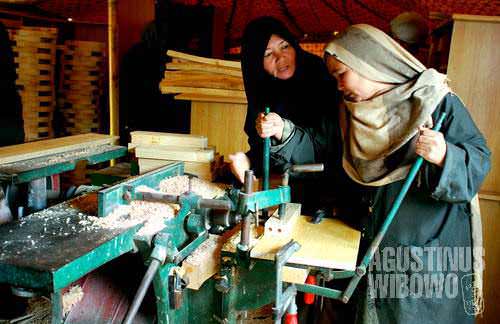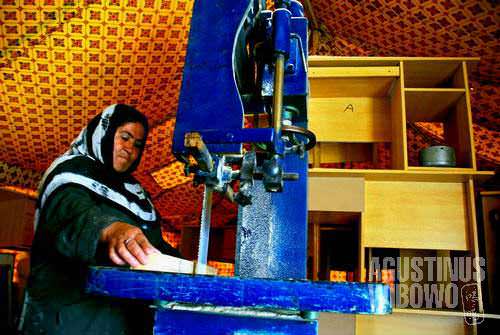Kabul – Women Carpenters from Afghanistan

Woman carpenters from Dasht Barchi. Most if not all of them are Hazaras.
Most people believe that carpentry is a man’s trade, but for the 60 carpentresses of Kabul’s Dasht-e-Barchi district, it simply isn’t true. “Women are able to do all kinds of work that men do,” they proclaim proudly.
Hidden among mud houses which sit idly off of the main road, the center for carpentry is a local shura (council) where women learn about basic carpentry and build various items from cupboards, tables, computer desks, chairs to sandalis (heaters).
A middle-aged woman is too happy to take me to the production center, where everything seems to happen all at once, located inside a small hut. “See, we are now able to handle heavy machinery,” she points out to several woodworking equipments that are modern-looking, where two or three women work in tandem to produce wood chops or create nail punctures and screw holes. Nails, chisels, hammers, sawing machines, screwdrivers are as familiar to these women as the pots and pans hanging inside their kitchens.
Fatima Akbari, 42, is one among a handful of optimistic war-widow who promotes carpentry for women in her neighborhood. She encourages them to become involve at the carpentry center. “There is no division between men and women when it comes to work. Tailoring used to be a woman’s job, now there are many opportunities for men in the trade. The same goes for carpentry.”

Women also need job, says her.
Doesn’t carpentry require strong physical condition?
“It does, but it doesn’t mean that [women] are not fit to do the job,” said Fatima. “For example, if a man can carry a log, it may be too heavy for a woman to do the same. But, between three of us, it’s not a problem, at all. We work together and we have the power of unity.”
Fatima, as well as other carpentresses, believes that carpentry gives them more than just a source of income, but also confidence.
The neighborhood council’s carpentry activity may be the only one in Kabul. It was initiated seven months ago under a six-month contract with CARE International, with hopes that the program will be extended. The NGO provides raw materials, machinery, tools and training. The Ministry of Women Affairs are responsible for getting women to enroll in the program. These women then receive proper training, are able to work at the center for half a day and, as a reward, they are also allowed to take home some of the things they have built througout the course. The council will also sell the products and distribute the profits for the community.
A large number of the women who work at the center are the breadwinners of their families. Some are even older than sixty-year-old, yet they’re still energetic when talking about wood production. “I have taken home a chair which I made myself,” said the grandmother proudly.
Job opportunities for Afghan women are usually limited to traditional works, such as tailoring, carpet weaving and making. “Carpentry is more interesting,” said an aging carpentress, “not only is it more interactive, it also generates more income than those traditional jobs.”
“Gender,” says Fatima, “is when women are given the same opportunity as men do. We may be standing far behind other countries, but now things are turning for the better.”




Nice report . . .
Keep rockin
Piye kabare?
I am always waiting your story. I hope your journey will be gathered into a book and share more picture to us.
Keep writing, Gus…
Temanku Agustinus
Aku baru sadar ternyata punya teman yang bisa melepas kemapanannya untuk sebuah Journey mencatat goresan sejarah.
Aku Hendra temen informatika – semoga kamu masih inget aku.
Aku masih inget, dulu kamu Kos di Perumdos ITS, dengan banyak sekali CD Play Station.
Aku tidak habis pikir, seorang Agustinus bisa menempuh jalan yang tidak semua orang mampu dan mau melakukannya, btw keep contact yah.
Kalau boleh tau apa sih yang membuat kamu bisa memutuskan menempuh jalan hidup yang berani dan penuh tantangan itu. (seperti dunia khayalan saja)